2002 Hyundai Getz ac system
[x] Cancel search: ac systemPage 266 of 428
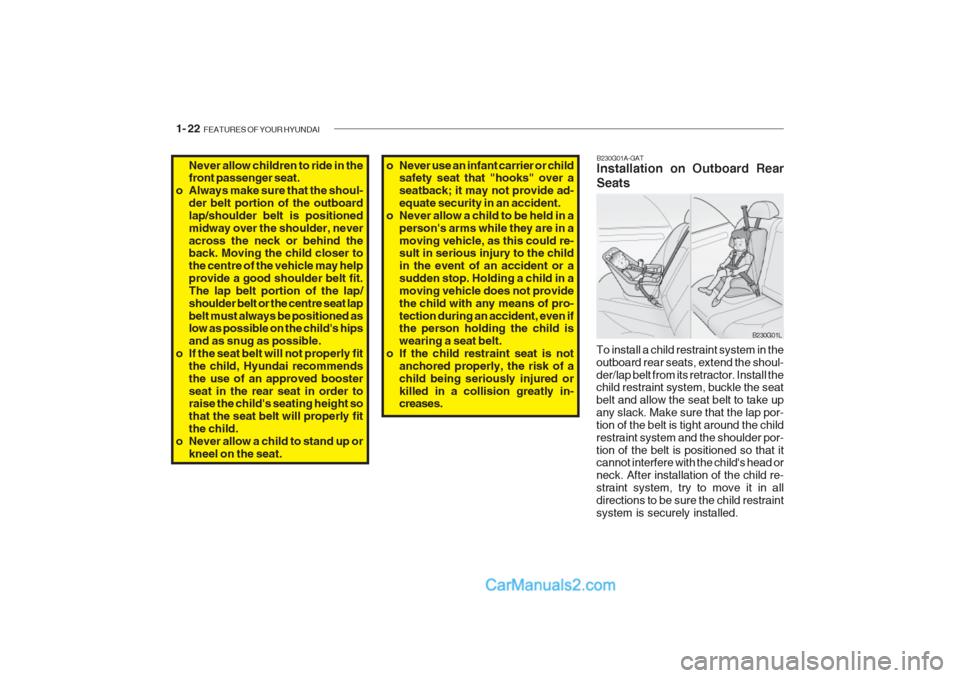
1- 22 FEATURES OF YOUR HYUNDAI
Never allow children to ride in the front passenger seat.
o Always make sure that the shoul- der belt portion of the outboard lap/shoulder belt is positionedmidway over the shoulder, neveracross the neck or behind the back. Moving the child closer to the centre of the vehicle may helpprovide a good shoulder belt fit.The lap belt portion of the lap/shoulder belt or the centre seat lapbelt must always be positioned as low as possible on the child's hips and as snug as possible.
o If the seat belt will not properly fit
the child, Hyundai recommendsthe use of an approved boosterseat in the rear seat in order to raise the child's seating height so that the seat belt will properly fitthe child.
o Never allow a child to stand up or kneel on the seat. o Never use an infant carrier or child
safety seat that "hooks" over aseatback; it may not provide ad-equate security in an accident.
o Never allow a child to be held in a person's arms while they are in amoving vehicle, as this could re- sult in serious injury to the child in the event of an accident or asudden stop. Holding a child in amoving vehicle does not providethe child with any means of pro-tection during an accident, even if the person holding the child is wearing a seat belt.
o If the child restraint seat is not anchored properly, the risk of achild being seriously injured orkilled in a collision greatly in- creases.
B230G01L
To install a child restraint system in the outboard rear seats, extend the shoul-der/lap belt from its retractor. Install the child restraint system, buckle the seat belt and allow the seat belt to take upany slack. Make sure that the lap por-tion of the belt is tight around the childrestraint system and the shoulder por-tion of the belt is positioned so that it cannot interfere with the child's head or neck. After installation of the child re-straint system, try to move it in alldirections to be sure the child restraintsystem is securely installed. B230G01A-GAT Installation on Outboard Rear Seats
Page 267 of 428

FEATURES OF YOUR HYUNDAI 1- 23
WARNING:
Do not install any child restraint sys- tem in the front passenger seat. Should an accident occur and cause the passenger side airbag to deploy,it could severely injure or kill aninfant or child seated in an infant orchild seat. Therefore, only use a childrestraint system in the rear seat of your vehicle.
If you need to tighten the belt, pull more webbing toward the retractor. When youunbuckle the seat belt and allow it toretract, the retractor will automaticallyrevert back to its normal seated pas- senger emergency locking usage con- dition. NOTE:
o Before installing the child restraint
system, read the instructions sup- plied by the child restraint systemmanufacturer.
o If the seat belt does not operate as
described, have the systemchecked immediately by your au-thorized Hyundai dealer.!
B230B01TB
B230B02A-GAT Using a Child Restraint System with "Tether Anchorage" Sys- tem For small children and babies, the use of a child seat or infant seat is strongly recommended. This child seat or infant seat should be of appropriate size forthe child and should be installed inaccordance with the manufacturer's in-structions. It is further recommendedthat the seat be placed in the vehicle's rear seat since this can make an impor- tant contribution to safety. Your vehicleis provided with three child restrainthook holders for installing the child seator infant seat. Spacer (10mm), Child Restraint Hook Holder
Holder Bolt (5/16"-30 mm) Washer, Conical Spring Holder, Child Restraint Hook
Retainer Washer B230E02FC-GAT Securing a Child Restraint Sys- tem with "Tether Anchorage" System Three child restraint hook holders are located on the vertical back panel.(behind rear bumper bar)
1. Route the child restraint seat strap
over the seatback. For vehicles with adjustable head- rests, route the tether strap underthe headrest and between the head-rest posts, otherwise route the tetherstrap over the top of the seatback.
Page 268 of 428
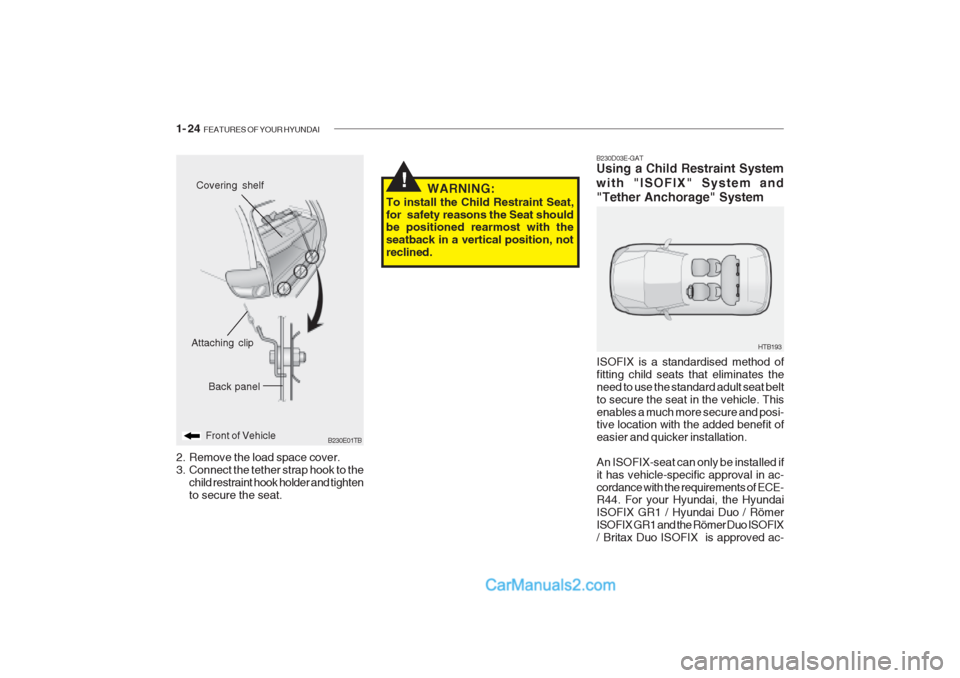
1- 24 FEATURES OF YOUR HYUNDAI
!
B230E01TB
Back panel
Front of Vehicle
Attaching clip
Covering shelf
2. Remove the load space cover.
3. Connect the tether strap hook to the child restraint hook holder and tightento secure the seat. B230D03E-GAT Using a Child Restraint System with "ISOFIX" System and "Tether Anchorage" System
ISOFIX is a standardised method of fitting child seats that eliminates theneed to use the standard adult seat beltto secure the seat in the vehicle. Thisenables a much more secure and posi- tive location with the added benefit of easier and quicker installation. An ISOFIX-seat can only be installed if it has vehicle-specific approval in ac-cordance with the requirements of ECE- R44. For your Hyundai, the Hyundai ISOFIX GR1 / Hyundai Duo / RömerISOFIX GR1 and the Römer Duo ISOFIX/ Britax Duo ISOFIX is approved ac-
HTB193
WARNING:
To install the Child Restraint Seat, for safety reasons the Seat should be positioned rearmost with the seatback in a vertical position, notreclined.
Page 269 of 428
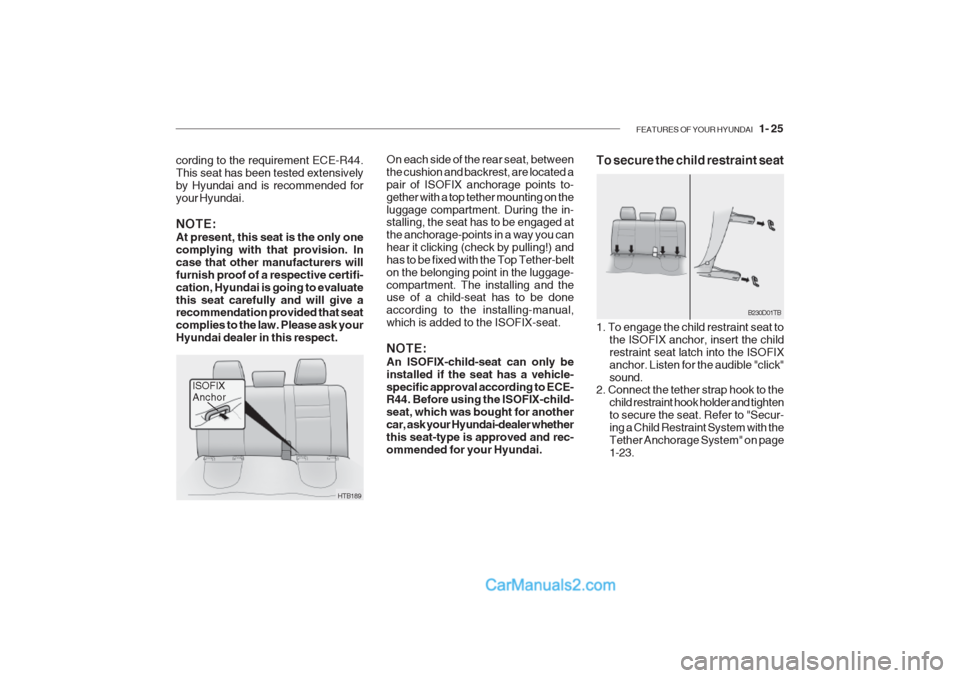
FEATURES OF YOUR HYUNDAI 1- 25
On each side of the rear seat, between the cushion and backrest, are located apair of ISOFIX anchorage points to-gether with a top tether mounting on theluggage compartment. During the in- stalling, the seat has to be engaged at the anchorage-points in a way you canhear it clicking (check by pulling!) andhas to be fixed with the Top Tether-belton the belonging point in the luggage-compartment. The installing and the use of a child-seat has to be done according to the installing-manual,which is added to the ISOFIX-seat. NOTE: An ISOFIX-child-seat can only be installed if the seat has a vehicle-specific approval according to ECE- R44. Before using the ISOFIX-child- seat, which was bought for anothercar, ask your Hyundai-dealer whetherthis seat-type is approved and rec-ommended for your Hyundai. B230D01TB
1. To engage the child restraint seat to the ISOFIX anchor, insert the childrestraint seat latch into the ISOFIXanchor. Listen for the audible "click"sound.
2. Connect the tether strap hook to the
child restraint hook holder and tightento secure the seat. Refer to "Secur-ing a Child Restraint System with theTether Anchorage System" on page1-23.
To secure the child restraint seatcording to the requirement ECE-R44. This seat has been tested extensivelyby Hyundai and is recommended foryour Hyundai. NOTE: At present, this seat is the only one complying with that provision. Incase that other manufacturers willfurnish proof of a respective certifi-cation, Hyundai is going to evaluatethis seat carefully and will give a recommendation provided that seat complies to the law. Please ask yourHyundai dealer in this respect.
HTB189
ISOFIX Anchor
Page 271 of 428
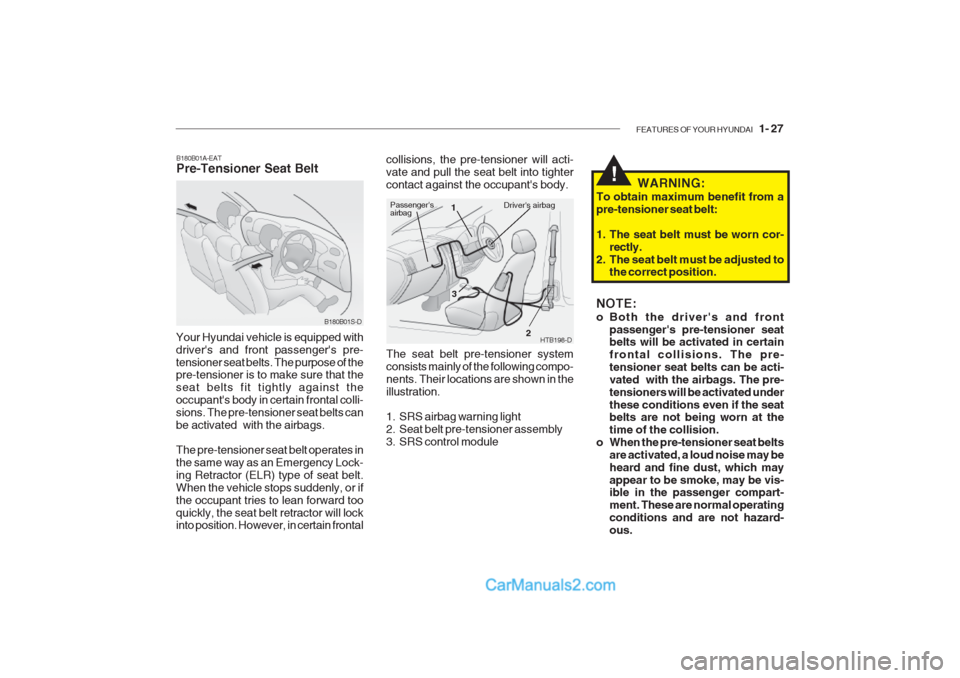
FEATURES OF YOUR HYUNDAI 1- 27
B180B01A-EAT Pre-Tensioner Seat Belt
B180B01S-D
Your Hyundai vehicle is equipped with driver's and front passenger's pre-tensioner seat belts. The purpose of the pre-tensioner is to make sure that the seat belts fit tightly against theoccupant's body in certain frontal colli-sions. The pre-tensioner seat belts canbe activated with the airbags. The pre-tensioner seat belt operates in the same way as an Emergency Lock-ing Retractor (ELR) type of seat belt.When the vehicle stops suddenly, or ifthe occupant tries to lean forward tooquickly, the seat belt retractor will lock into position. However, in certain frontal
collisions, the pre-tensioner will acti- vate and pull the seat belt into tightercontact against the occupant's body. The seat belt pre-tensioner system consists mainly of the following compo-nents. Their locations are shown in theillustration.
1. SRS airbag warning light
2. Seat belt pre-tensioner assembly
3. SRS control module HTB198-D
Driver's airbag1
2
3Passenger's airbag
WARNING:
To obtain maximum benefit from a pre-tensioner seat belt:
1. The seat belt must be worn cor- rectly.
2. The seat belt must be adjusted to the correct position.
!
NOTE:
o Both the driver's and front
passenger's pre-tensioner seat belts will be activated in certain frontal collisions. The pre-tensioner seat belts can be acti-vated with the airbags. The pre-tensioners will be activated underthese conditions even if the seat belts are not being worn at the time of the collision.
o When the pre-tensioner seat belts
are activated, a loud noise may beheard and fine dust, which mayappear to be smoke, may be vis- ible in the passenger compart- ment. These are normal operatingconditions and are not hazard-ous.
Page 272 of 428

1- 28 FEATURES OF YOUR HYUNDAI
o Although it is harmless, the fine
dust may cause skin irritation and should not be breathed for pro-longed periods. Wash your handsand face thoroughly after an acci- dent in which the pre-tensioner seat belts were activated. it illuminates whilst the vehicle isbeing driven, please have an au-thorized Hyundai dealer inspectthe pre-tensioner seat belt or SRSairbag system as soon as pos- sible.
o Do not attempt to service or repair
the pre-tensioner seat belt systemin any manner.
o Improper handling of the pre- tensioner seat belt assemblies, and failure to heed the warnings to notstrike, modify, inspect, replace,service or repair the pre-tensioner seat belt assemblies may lead to improper operation or inadvertentactivation and serious injury.
o Always wear the seat belts when driving or travelling in a motorvehicle.
CAUTION:
o Because the sensor that activates the SRS airbag is connected withthe pre-tensioner seat belt, the SRSairbag warning light on theinstrument panel will blink forapproximately 6 seconds after the ignition key has been turned to the "ON" position and then it shouldturn off.
o If the pre-tensioner seat belt is not
working properly, this warninglight will illuminate even if there is no malfunction of the SRS airbag system.If the SRS airbag warning lightdoes not illuminate when the igni-tion key is turned to "ON", or if itremains illuminated after blinking for approximately 6 seconds, or if WARNING:
o Pre-tensioners are designed to op- erate only one time. After activa- tion, pre-tensioner seat belts must be replaced. All seat belts, of any type, should always be replacedafter they have been worn during acollision.
o The pre-tensioner seat belt assem-
bly mechanisms become hot dur- ing activation. Do not touch the pre-tensioner seat belt assembliesfor several minutes after they havebeen activated.
o Do not attempt to inspect or re-
place the pre-tensioner seat belts yourself. This must be done by an authorized Hyundai dealer.
o Do not strike the pre-tensioner seat
belt assemblies.
!!
Page 273 of 428
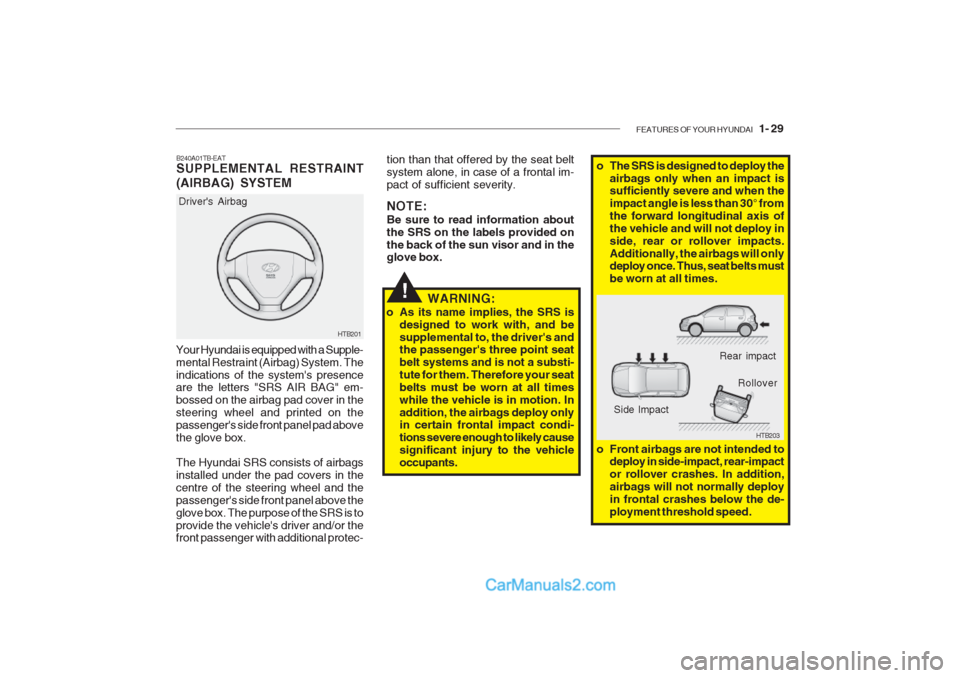
FEATURES OF YOUR HYUNDAI 1- 29
HTB201
Driver's Airbag
Your Hyundai is equipped with a Supple- mental Restraint (Airbag) System. Theindications of the system's presence are the letters "SRS AIR BAG" em- bossed on the airbag pad cover in thesteering wheel and printed on thepassenger's side front panel pad abovethe glove box. The Hyundai SRS consists of airbags installed under the pad covers in thecentre of the steering wheel and thepassenger's side front panel above theglove box. The purpose of the SRS is toprovide the vehicle's driver and/or the front passenger with additional protec- B240A01TB-EAT SUPPLEMENTAL RESTRAINT (AIRBAG) SYSTEM
HTB203
Rear impact
Side Impact Rollover
tion than that offered by the seat belt system alone, in case of a frontal im-pact of sufficient severity. NOTE: Be sure to read information about the SRS on the labels provided onthe back of the sun visor and in the glove box.
!WARNING:
o As its name implies, the SRS is designed to work with, and be supplemental to, the driver's and the passenger's three point seat belt systems and is not a substi-tute for them. Therefore your seatbelts must be worn at all timeswhile the vehicle is in motion. Inaddition, the airbags deploy only in certain frontal impact condi- tions severe enough to likely causesignificant injury to the vehicleoccupants. o The SRS is designed to deploy the
airbags only when an impact is sufficiently severe and when the impact angle is less than 30° fromthe forward longitudinal axis ofthe vehicle and will not deploy inside, rear or rollover impacts.Additionally, the airbags will only deploy once. Thus, seat belts must be worn at all times.
o Front airbags are not intended to deploy in side-impact, rear-impactor rollover crashes. In addition,airbags will not normally deployin frontal crashes below the de-ployment threshold speed.
Page 274 of 428

1- 30 FEATURES OF YOUR HYUNDAI
o For maximum safety protection in
all types of crashes, all occupants including the driver should alwayswear their seat belts whether ornot an airbag is also provided attheir seating position to minimize the risk of severe injury or death in the event of a crash. Do not sit orlean unnecessarily close to theairbag while the vehicle is in mo-tion.
o The SRS airbag system must de- ploy very rapidly to provide pro-tection in a crash. If an occupant isout of position because of notwearing a seat belt, the airbag mayforcefully contact the occupantcausing serious or fatal injuries.
The SRS consists of the following com- ponents:
- Driver's Airbag Module
- Passenger's Airbag Module
- SRS Service Reminder Indicator
(SRI)
- SRS Control Module (SRSCM) The SRSCM continually monitors all elements while the ignition is "ON" todetermine if a frontal or near-frontalimpact is severe enough to requireairbag deployment.
B240B03A-DAT SRS Components and Functions
The SRS service reminder indicator (SRI) on the instrument panel will blink for about 6 seconds after the ignitionkey is turned to the "ON" position orafter the engine is started, after whichthe SRI should go out.
B240B01L-D
B240B02L-D